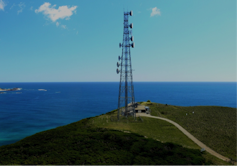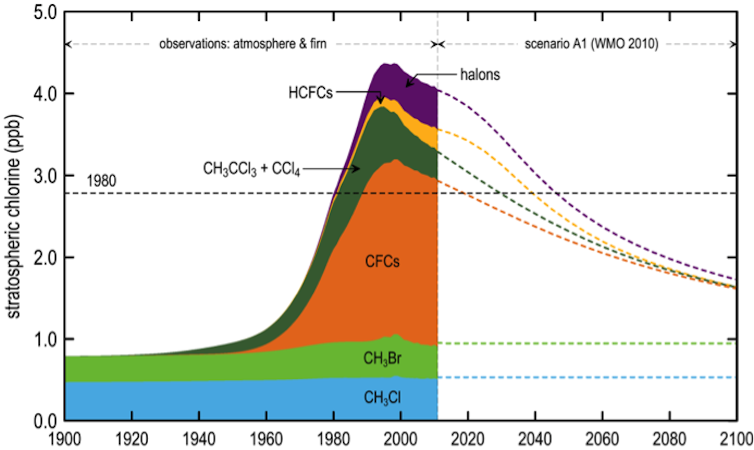SAVING THE OZONE: Part four in our series exploring the Montreal Protocol on Substances that Deplete the Ozone Layer – dubbed “the world’s most successful environmental agreement” – looks at the substances that caused all this trouble in the first place.
In 1974, the world was alerted to the possible catastrophic depletion of stratospheric ozone by chlorofluorocarbons (CFCs), which were then emitted from domestic and commercial refrigeration and from air conditioning equipment, plastic foams and aerosol cans. Before 1974, CFCs were thought of as harmless chemical artifacts in the atmosphere, useful as tracers of the movement of air between countries and hemispheres.
In order to assess this threat to stratospheric ozone, which absorbs most of the harmful solar ultraviolet radiation impinging on the Earth’s atmosphere, scientists needed accurate information on the amounts and accumulation rates of CFCs in the global background atmosphere. Several nations, in particular Australia, the UK and the USA, responded quickly to this challenge. They established CFC-monitoring facilities in a number of strategic, clean-air locations around the world, in part funded by the global CFC industry.
CSIRO established the first Southern Hemispheric CFC measurement laboratory at Aspendale, Victoria, in 1975, and commenced in-situ measurements at Cape Grim, Tasmania, in early 1976. The Cape Grim station, funded and managed by the Australian Bureau of Meteorology, monitors and studies global atmospheric composition in a science program led by CSIRO and the Bureau.
By the early 1980s the atmospheric data, coupled with the industry estimates of global CFC production and emissions, proved that CFCs were long-lived, lasting more than 50 years in the atmosphere. This long life meant they could reach the stratosphere, where they broke down, releasing reactive chlorine species that catalytically destroyed ozone.

Scientists also realised that CFCs were not the only important ozone depleting substances (ODS) being released to the atmosphere. The chlorinated solvents carbon tetrachloride, and former dry-cleaning agents methyl chloroform, were identified as significant ODS. So were the halons – bromine containing fire-fighting chemicals – and methyl bromide, an agricultural and structural fumigant. The latter chemicals were identified as particularly potent ODS because they contained bromine, even more destructive of stratospheric ozone than chlorine.
To rapidly phase out CFCs, the industry developed the already existing HCFCs as interim replacement refrigerants and foaming agents. Hydrocarbons were developed as long-term replacements for CFCs in aerosol propellants. HCFCs were themselves ODSs, but because of their relatively short atmospheric lifetimes they were significantly less potent than the CFCs they replaced.
By 1987, just over a decade after the ozone threat was enunciated, the nations of the world came together to sign the Montreal Protocol, which controlled the production and consumptions of ODSs including HCFCs. Around the same time, the industry announced that it had developed safe, ozone-friendly CFC replacements, the hydrofluorocarbons (HFCs).
Unlike the CFCs and chlorinated solvents, accurate and comprehensive measurements of HCFCs, HFCs, the halons and methyl bromide were only possible by the mid-1990s. This was thanks to the development of a suitable measurement technology - gas chromatography-mass spectrometry (GC-MS) - and reliable calibration standards.
CSIRO and the Bureau of Meteorology had an archive of clean air samples collected regularly at Cape Grim since 1978 (the Cape Grim Air Archive). In the late 1990s, CSIRO got GC-MS capability and - in partnership with international laboratories at the University of California at San Diego, USA and the University of East Anglia at Norwich, UK - were able to reconstruct the complete ODS atmospheric history at Cape Grim back to 1978. CSIRO also applied these techniques to the analysis of air samples extracted in Antarctica, extending the complete ODS atmospheric history back to the 1930s.

The latest ODS data, as measured at Cape Grim, in the Cape Grim Air archive and in Antarctica are shown in Figure 2, expressed as the amount of chlorine potentially available for ozone destruction in the stratosphere.
The Cape Grim ODS data are available at the World Data Centre for Greenhouse Gases. The Cape Grim Air Archive and Antarctic firn ODS data are available on request from the authors.
Chlorine levels rose rapidly from the 1960s, peaking in the late-1990s at about 4.4 parts per billion molar, before starting to decline, thanks to the successful implementation of the Montreal Protocol. Currently chlorine levels are falling by 6% per decade and it is anticipated they will fall to 1980s levels by about 2045 if the world continues to adhere to the Protocol. By then it is likely that the Antarctic ozone hole will be very weak or non-existent.
Tomorrow: the parallels between saving ozone and fighting climate change.
Read more on the Montreal Protocol’s 25th anniversary.


